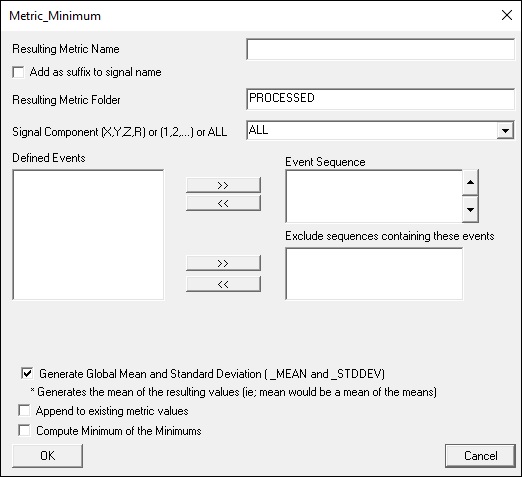Metric Minimum
Jump to navigation
Jump to search
Compute the Minimum Value of a Signal and store the value as a metric
In the following example, compute the Minimum Value of the signal HANDSPEED
| Metric_Minimum | ||
| /RESULT_METRIC_NAME= | _MEAN | The type of signal created |
| /APPLY_AS_SUFFIX_TO_SIGNAL_NAME= | True | Specify the metric name to be the ORIGINAL signal plus a SUFFIX |
| /RESULT_METRIC_FOLDER= | PROCESSED | |
| /SIGNAL_TYPES= | DERIVED | |
| /SIGNAL_NAMES= | HANDSPEED | Specify the Signal to be used |
| /SIGNAL_FOLDER= | PROCESSED | |
| /SIGNAL_COMPONENTS= | ALL_COMPONENTS | Specify the Signal components to be used (e.g. X, Y, Z or 0, 1, 2 etc) |
| /EVENT_SEQUENCE= | FRAME1 + GO | Specify the sequence of Events. Any number of Events can be entered (separated by +). This specific sequence of events must be true for a metric to be computed. The metric is computed from the first event in the sequence to the last event in the sequence |
| /EXCLUDE_EVENTS= | SPEED_CHANGE | If this event occurs before the first and last event, do not compute a metric |
| /SEQUENCE_PERCENT_START= | Within the event sequence specify the beginning of the range as a percent | |
| /SEQUENCE_PERCENT_END= | Within the event sequence specify the end of the range as a percent | |
| /GENERATE_MEAN_AND_STDDEV= | TRUE | Generate the mean and standard deviation of this metric across ranges and files |
| /APPEND_TO_EXISTING_VALUES== | FALSE | Do not Add these metric values to an existing metric |
| ! /CREATE_GLOBAL_MINIMUM= | FALSE | Create a metric in the GLOBAL Workspace containing the minimum of the minimums |
| ; |
